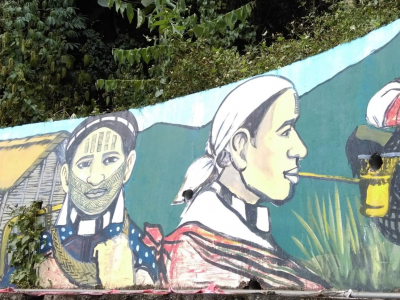2018年出版的一本著作記錄了菲律賓社區廣播網面臨的挑戰。作者採訪了本書計畫背後的其中一個團體,訪問社區廣播在菲律賓的重要性。在這個國家,大多數被謀殺的記者都是來自農村省份的廣播員。
該書的標題是「放大人民的聲音:菲律賓社區廣播的經驗與挑戰」(Amplifying the People’s Voices: The Philippine Community Radio Experience and Challenges),由國際婦女廣播電視協會(International Association of Women in Radio and Television)和Kodao製作公司出版。 [註:Kodao為全球之聲的內容合作夥伴。]
Kodao執行董事Jola Diones-Mamangun透過電子郵件分享該書的幾條重點,以及社區廣播在總統杜特蒂(Rodrigo Duterte)政府領導下面臨的當前挑戰。首先,她解釋社區廣播的意涵:
Community radio is broadcasting or ‘narrowcasting’ by a community on a topic that is of importance to them through a (usually) low-power radio transmitter (broadcasting) or a public-address system (narrowcasting). It is a form of a town-hall meeting that uses the radio program format. Both the broadcaster/s and the interviewee/s are usually members of the community themselves. If the community succeeds in putting a community radio station, they broadcast a series of programs that is similar to how other radio stations operate (eg, Radyo Sagada). If not, they can set up a public address system and place speakers around the community and the program/s usually last for just hours (eg. Radyo San Roque).
社區廣播是由一社群進行廣播或「窄播」(narrowcasting)對該社區重要的議題。廣播(通常)透過低功率無線電發射器傳播,窄播則透過公共傳輸系統播送。社區廣播是以廣播節目模式舉行的一種市民大會(town-hall meeting),廣播員和受訪者通常都是社區本身的成員。如果社區成功設立社區廣播電台,便會廣播一系列與其他電台運作方式類似的節目(例:Sagada廣播電台)。倘若失敗,則可建立一套公共傳輸系統,並在社區各處放置擴音器進行窄播,節目長度通常只有短短幾小時(例:San Roque廣播電台)。
上文前者Sagada位於菲律賓北部的科迪勒拉地區(Cordillera Region),是原住民族伊哥洛特人(Igorot)的故鄉。後者San Roque則是菲律賓首都馬尼拉大都會(Metro Manila)的都市貧困區。
Jola提到1990年代初期,社區廣播電台如何形成一個廣播網:
There have been earlier stand-alone community radio stations in the Philippines but it was only in the early 1990s that the late Louie Tabing started the Tambuli network of community radio stations. He is acknowledged in the global community radio broadcasting movement as an Asian pioneer.
菲律賓很早就有獨立的社區廣播電台,但直到1990年代初,已故的路易·塔賓(Louie Tabing,對菲律賓和孟加拉的社區廣播有極大貢獻)才開始建立社區廣播電台的Tambuli廣播網。他在全球社區廣播運動中被公認為亞洲的先驅。

「放大人民的聲音:菲律賓社區廣播的經驗和挑戰」(Amplifying the People’s Voices: The Philippine Community Radio Experience and Challenges)。來源:Kodao。
她表示,Kodao的努力是受到Tambuli廣播網的啟發。有了學術界、教堂、國際非政府組織以及社區本身等各個部門的協助,Tambuli計畫率先在菲律賓各地的偏遠村莊建立了20多個社區廣播電台。
接著,她總結過去二十年來社區廣播面臨的主要挑戰:
Sustainability is the main challenge. When funding for Tambuli dried up, most of the stations became moribund, shriveling the network and stopping the project on its tracks.
Second problem are the laws that appear to discourage the establishment of independent community radio stations. For example, while there are more than a hundred Radyo Natin stations all over the archipelago—low-power Manila Broadcasting Company (MBC)-owned stations—there are very few genuine community radio stations such as Radyo Sagada. It is unjust that large networks such as MBC are given hundreds of frequencies on both AM and FM bands that it is no longer possible, for example to put a radio station in the Metro Manila area, or Cebu, Iloilo, Davao and others. What if the Dumagats of Antipolo want to have a radio station of their own? [Dumagats are indigenous peoples from Rizal province. Antipolo is part of Rizal, located east of Metro Manila].
Third, because they are non-profit, community-owned and operated, and assisted by non-government organizations, genuine community radio stations are often victims of attacks and harassments, leading to their closure or abortion of their establishment. Radyo Cagayano was burned down and its staff attacked in Baggao, Cagayan in 2006; Radyo Sugbuanon’s full operation was aborted because of threats by the police and politicians; Radyo Lumad was closed last January 2019 because of threats and harassments. NGOs that help put them up are red-tagged and some have even been killed or imprisoned.
永續性是主要挑戰。Tambuli計畫的資金枯竭時,大多數電台都瀕臨癱瘓,開始縮小網路規模,計畫停滯不前。
第二個問題是,法律似乎不鼓勵設立獨立的社區廣播電台。舉例來說,雖然整個群島上有一百多個Natin廣播電台(低功率的馬尼拉廣播公司(Manila Broadcasting Company, MBC)擁有的電台),但如Sagada廣播電台這種真正的社區廣播電台卻很少。不公平的是,像MBC這樣的大型廣播網在調幅廣播(AM)和調頻廣播(FM)上佔用了數百個頻率,所以其他人根本不可能有機會--譬如在馬尼拉大都會地區、或宿霧(Cebu)、怡朗(Iloilo,另譯「伊洛伊洛」)、達沃(Davao)等地設置廣播電台。如果安蒂波洛(Antipolo)的杜馬加特人(Dumagats)想擁有自己的廣播電台怎麼辦?[註:安蒂波洛位於馬尼拉大都會以東的黎剎省(Rizal province),杜馬加特人是該省的原住民。]
第三,由於真正的社區廣播電台是非營利、由社區持有及運作的,且接受非政府組織協助,因此這些電台常常受到攻擊與騷擾,致使關閉或中止設置。Cagayano廣播電台在2006年慘遭祝融,工作人員在卡加煙省(Cagayan)的Baggao遇襲;Sugbuanon廣播電台本來全面運作,卻因警察和政客的威脅而中止;Lumad廣播電台則於2019年1月遭威脅和騷擾而關門大吉。為電台提供協助的非政府組織會被政府特別關注(red-tagged),其中一些成員甚至已被滅口或關押。[編按:菲律賓的「red-tagging」(貼上紅色標籤)通常針對批評政府的民眾或組織,被貼標籤者可能面臨政府的不實指控等,國際組織認為此標籤有違並破壞菲律賓的民主制度。]
Cagayano廣播電台、Lumad廣播電台和Sugbuanon廣播電台所在的社區居民不是在抵制採礦集團的進入和擴張,就是在反對可能破壞其家園和生計的大型計畫。這些廣播電台長期都與可能被迫搬遷的社區合作,廣播上述議題,並為當地居民提供一個表達訴求的平台。但也正是「放大人民的聲音」這一使命,導致向掌權者吐露真言的人遭到惡意攻擊。
Jola強調「人民的傳播權」應成為菲律賓廣泛追求實質發展和包容性民主的一部分:
These are no small challenges that could be addressed by simple problem-solving. There must a systemic social change if community radio is to finally succeed in the Philippines. It must be pursued as part of the people’s right to communication. If the marginalized are underserved by the mass media establishment, they must be allowed to be their own voice (as opposed to claims that they are voiceless and that the networkers are giving them one.)
這些挑戰都不容易,都不是可以輕鬆解決的問題。如果社區廣播最終想在菲律賓取得成功,就必須進行系統性的社會改革。這必須以人民的傳播權為願景來追求。如果大眾媒體對邊緣群體的服務不足,這些群體則必須有機會為自己發聲(這與聲稱「他們無法發聲,且媒體工作者正在給他們一個發聲管道」的說法恰恰相反)。
她指責2016年上台的杜特蒂政府允許[外部人士]對獨立媒體施以比以往更多攻擊行為,受害方包含社區廣播電台:
It is under the Duterte regime that Radyo Sugbuanon and Radyo Lumad have been threatened, leading to the abortion of the former’s full establishment and the closure of the latter.
在杜特蒂政權下,Sugbuanon廣播電台和Lumad廣播電台皆受到威脅,導致前者中止全面設立廣播網,後者也逃不了關閉的命運。
她表示,Kodao公司計劃將這本書提供給全國各地的大眾傳播院校,作為學習資源。她也補充道,這本書可以成為菲律賓推動法案運動的一環,用以推行友善社區廣播電台的相關法律。








